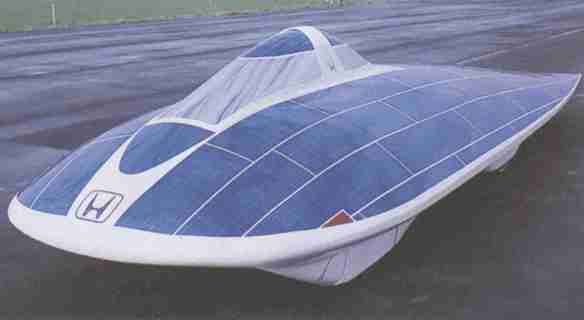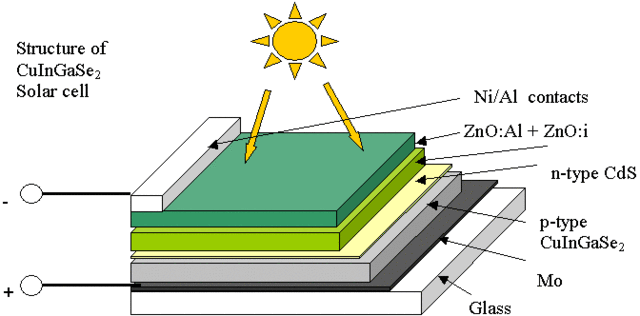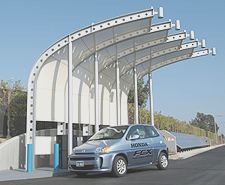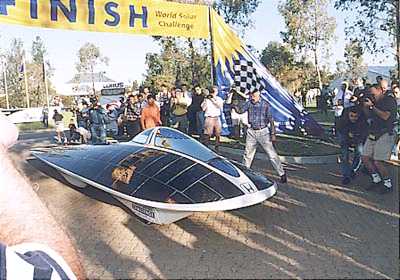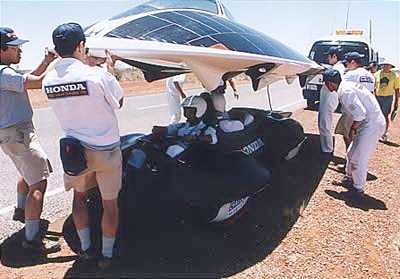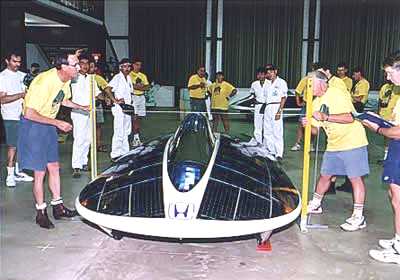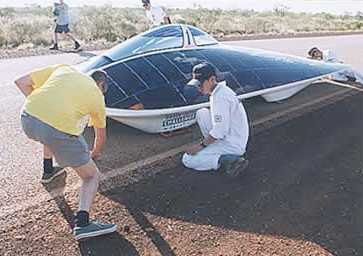|
HONDA SOLAR CAR JAPAN
|
||||||||||||||||||||||||||||||||||||||||||||||||||||||||||||||||||||||||||||||||||||||||||||||||||||||||||||||||||||||||||||||||||||||||||||||||||||||||||||||||||||||||||||||||||||||||||||||||||||||||||||||||||||||||||||||||||||||||||||||||||||||||||||||||||||||
|
HOME | BIOLOGY | BOOKS | FILMS | GEOGRAPHY | HISTORY | INDEX | INVESTORS | MUSIC | NEWS | SOLAR BOATS | SPORT |
||||||||||||||||||||||||||||||||||||||||||||||||||||||||||||||||||||||||||||||||||||||||||||||||||||||||||||||||||||||||||||||||||||||||||||||||||||||||||||||||||||||||||||||||||||||||||||||||||||||||||||||||||||||||||||||||||||||||||||||||||||||||||||||||||||||
|
One
time winner of the Darwin to Adelaide race and arguably, the most
expensive solar powered vehicle project to date, and one of the most
beautiful. This Honda car was used
very successfully to advertise Honda road vehicles. This sums spent
developing this car would have built and equipped the Solar
Navigator trimaran. Honda
- Darwin to Adelaide winner Entrants
in the cross Australia race, from Darwin to Adelaide, use solar panels
to power a lightweight car over 2,000 miles at speeds of up to 50 miles
per hour. Clearly, solar power can deliver
enough energy to drive a vehicle considerable distance given the right
conditions. Nikkei.
Honda Motor is entering the market for solar cells designed for use in
households and also plans to promote their use in vehicles, according to
a report in the Nihon Keizai Shimbun. Honda
is building a ¥10-billion (US$86.5-million) factory to begin mass
production in fiscal 2007 of solar cells made an inexpensive
thin-membrane non-silicon metal compound developed by Honda engineering.
The Honda solar panels, first announced in 2002, feature a
light-absorbing layer formed by a compound made of copper, indium,
gallium and diselenium (CIGS).
Thin-film
solar cells based on CIGS (Cu(In,Ga)Se2) absorbers are among
the leading devices which are expected to lower the costs for
photovoltaic energy conversion. Other companies working with CIGS cells
include Shell Solar and Würth.
Early
Honda CIGS module prototypes had a maximum output of 112 W at dimensions
of 1,367 × 802 × 46 mm. Honda is working to improve the efficiency.
Honda’s
solar cells will likely sell for some 1.5 million yen each, 20%-30% less
than silicon-made cells, according to the report.
The
new plant will initially have an annual capacity to produce about 30
megawatts worth of solar cells, enough for 10,000 households a year.
Initially, the company aims to market them only in Japan. But it will
later sell them in overseas markets, eyeing mainly North America and
Europe, where demand is expected to surge in the future.
Honda
is also considering a scheme that would use solar cells to power a home
electrolysis unit for the production of hydrogen for vehicle refueling.
Honda’s current prototype home hydrogen energy
systems rely on natural gas reforming.
Honda
combined its CIGS solar cells with a Honda-developed compact
electrolysis unit that uses a new Ruthenium-based catalyst in a
prototype at its Torrance, California facility. The
prototype solar-powered electrolysis unit produces hydrogen at a rate of
2 normal cubic meters per hour (Nm3/hr). Honda
- Crossing the finish line ORGANISATION
A-Z CAR'S
NAME TEAM
NAME Helios Faculty
of Engineering Sol
of Auburn Sol
of Auburn Aurora Aurora
Vehicle Association Das
SolarCar der Fachhochschule SLO
Burn Sidewinder The
Solar Knights Dark
Horse EAC
Skunkworks Heliodet Surya,
Ratha, Mercury Fusion Paragon Tesseract McGill
University
Monteal, Canada McMaster
Uni
Solar Car Project Genesis
II Solar Racing Team The
Double Deuce Sunsetters
- Solar Race Team N'Uvation Het
Nuon Solar Team OSU
model S Solaris Sun
Panthers RA
6 Principia
College
Solar Car Team SPOT
2 Purdue
University
Solar Racing Queen's
University Canada Red
River College Solar
Car Team Cougar
Cruiser Solar
Motion Solstice Tamagawa
Solar Challenge Project FUTURA
2 Phaethon
model Team
SunLake TOYOBO Columbia
Sunraycer Texas
A&M
Motorsports Team The
Power of One
- Toronto Xof1 The
Xof1 solar car team Drifter UC
Calgary
Solar Car Team Solution,
CATalyst KSU
Solar Car Racing Team Gato
del Sol II Borealis
III U
of M Solar Vehicle Project Suntiger
VI The
Mizzou Solar Car Project UOI
Solar Vehicle Team UNSW
Sunswift III Keystone Queensland
Solar Team Solar
Steer Solraycers Heliotrope
Solar Car Team Sunseeker
05 SOLAR CAR EVENTS American
World Solar Challenge - Formula Sun
Australian
World Solar Challenge Canadian
Solar Discovery Challenge
Dream
Cup Solar Car Race Suzuka 2003 - Japan
Japanese
World Solar Car Rallye
North
American Solar Challenge
Solar
Express - Solar Bike Race
Honda
- Solar car bodywork lifted clear During
these competitions, students learn about solar panels, electric motors,
electronics, vehicle chassis, bodywork, aerodynamics, suspension, batteries
and how to solve practical problems during the design process, while working
as a team. It's demanding stuff and more fun that laying in bed
watching TV, where individuals may seek inspiration, but achieve very
little.
1.
Chassis
- and seating 2.
Mechanics
- suspension, steering, brakes 5.
Solar
Array - usually part of body 7.
Electrical
System - and instruments 8.
Driver
Controls - switches, lighting, etc
9.
Bodywork
- Screen, etc Race
officials keep tight reign on entrants
A
SUSTAINABLE FUTURE Never
mind the politics, people need a place to live, food and energy.
Imagine a world where there is abundant energy for transport, the home
and our factories, and that energy does not harm our environment.
Imagine that the world economy is stable and that the
population is
under the threshold where the planet can meet our needs. Isn't that a
wonderful vision? That
ideal may not be totally within our grasp. But we can at least strive
for clean energy for living, which is technologically within sight.
RENEWABLE
ELECTRICITY Solar
power from
micro generation is now a growing industry as many Youtube videos are
demonstrating. As these conversions and new builds gain in popularity
electric vehicles will also gain favour, especially for households
generating excess energy, which they could get better value from by
using for transport. Electricity used in this way might reduce transport
costs
by up to 200%. So provide a higher quality of life with lesser
environmental damage. If
buying an EV, it would make
sense to have the latest future proof technology, such as battery
cartridge exchange built into the vehicle, for self servicing, or
exchanges at local stores or cooperatives. This technology exists but
has not yet been incorporated in production
vehicles. When
EVs become available with cartridge
refueling, it would make sense to have in place at least a few
service stations to cater for eventual demand. The technology would thus
be in place when it is needed. Such a move when it is implemented will
greatly reduce carbon
dioxide build up in the atmosphere and ease the transition from oil
based economies to abundant clean energy. THE
CHICKEN AND EGG SITUATION If
there were service forecourts to cater for battery cartridge exchange,
that might in turn persuade motor manufacturers to produce vehicles with
the system. This is a classic chicken
and egg situation. Who should do what first. Given
the scale of the problem, it might be prudent for every corporation
involved in the industry to at least investigate the potential that any
emerging technology might offer for the future on mankind,
which is after all the future of their company and eventual profits for
their shareholders. WSC
2011 - Panasonic
Solar Cola drinkers care about climate chaos ......
....... Pioneering research for the Planet
|
||||||||||||||||||||||||||||||||||||||||||||||||||||||||||||||||||||||||||||||||||||||||||||||||||||||||||||||||||||||||||||||||||||||||||||||||||||||||||||||||||||||||||||||||||||||||||||||||||||||||||||||||||||||||||||||||||||||||||||||||||||||||||||||||||||||
|
This
website
is Copyright © 1999 & 2012 Electrick Publications.
The bird |
||||||||||||||||||||||||||||||||||||||||||||||||||||||||||||||||||||||||||||||||||||||||||||||||||||||||||||||||||||||||||||||||||||||||||||||||||||||||||||||||||||||||||||||||||||||||||||||||||||||||||||||||||||||||||||||||||||||||||||||||||||||||||||||||||||||
|
AUTOMOTIVE | BLUEPLANET | ELECTRIC CARS | ELECTRIC CYCLES | SOLAR CARS |
